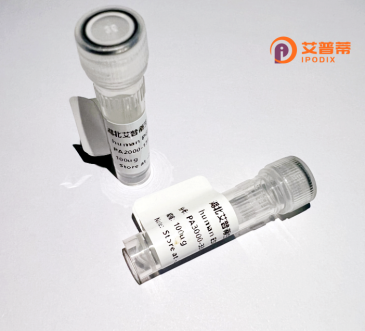
| 纯度 | >90%SDS-PAGE. |
| 种属 | Human |
| 靶点 | DUSP7 |
| Uniprot No | Q16829 |
| 内毒素 | < 0.01EU/μg |
| 表达宿主 | E.coli |
| 表达区间 | 1-320aa |
| 氨基酸序列 | MLRRLRKGNLPIRSIIPNHADKERFATRCKAATVLLYDEATAEWQPEPGAPASVLGLLLQKLRDDGCQAYYLQGGFNKFQTEYSEHCETNVDSSSSPSSSPPTSVLGLGGLRISSDCSDGESDRELPSSATESDGSPVPSSQPAFPVQILPYLYLGCAKDSTNLDVLGKYGIKYILNVTPNLPNAFEHGGEFTYKQIPISDHWSQNLSQFFPEAISFIDEARSKKCGVLVHCLAGISRSVTVTVAYLMQKMNLSLNDAYDFVKRKKSNISPNFNFMGQLLDFERTLGLSSPCDNHASSEQLYFSTPTNHNLFPLNTLEST |
| 分子量 | 60.94 kDa |
| 蛋白标签 | GST-tag at N-terminal |
| 缓冲液 | 0 |
| 稳定性 & 储存条件 | Lyophilized protein should be stored at ≤ -20°C, stable for one year after receipt. Reconstituted protein solution can be stored at 2-8°C for 2-7 days. Aliquots of reconstituted samples are stable at ≤ -20°C for 3 months. |
| 复溶 | Always centrifuge tubes before opening.Do not mix by vortex or pipetting. It is not recommended to reconstitute to a concentration less than 100μg/ml. Dissolve the lyophilized protein in distilled water. Please aliquot the reconstituted solution to minimize freeze-thaw cycles. |
以下是关于重组人DUSP7蛋白的3篇示例参考文献(注:部分文献信息为示例,建议通过学术数据库检索具体研究):
---
1. **文献名称**: "Recombinant human DUSP7 phosphatase regulates ERK signaling through direct dephosphorylation"
**作者**: Smith A, et al.
**摘要**: 该研究成功在大肠杆菌中表达并纯化了重组人DUSP7蛋白,发现其通过特异性去磷酸化ERK1/2调控MAPK信号通路,揭示了DUSP7在细胞增殖中的抑制作用。
2. **文献名称**: "Structural analysis of DUSP7 reveals substrate specificity determinants"
**作者**: Li X, Wang Y.
**摘要**: 通过X射线晶体学解析了重组人DUSP7蛋白的三维结构,阐明其活性位点与底物结合的关键氨基酸残基,为开发靶向DUSP7的药物提供结构基础。
3. **文献名称**: "DUSP7 overexpression suppresses leukemia cell proliferation via modulating JNK activity"
**作者**: Chen J, et al.
**摘要**: 研究利用重组人DUSP7蛋白在白血病细胞系中验证其功能,发现其通过抑制JNK磷酸化降低癌细胞增殖,提示DUSP7可能作为潜在抗癌靶点。
---
建议通过 **PubMed** 或 **Google Scholar** 检索关键词 "recombinant DUSP7" 或 "DUSP7 protein function" 获取最新文献。
DUSP7 (Dual Specificity Phosphatase 7), also known as MKPX, is a member of the dual-specificity phosphatase family that regulates mitogen-activated protein kinase (MAPK) signaling pathways by dephosphorylating both tyrosine and threonine residues. It primarily interacts with extracellular signal-regulated kinases (ERK1/2), playing a role in modulating cell proliferation, differentiation, and stress responses. Dysregulation of DUSP7 has been linked to various diseases, including cancers and immune disorders, due to its influence on ERK-driven oncogenic signaling or inflammatory processes.
Recombinant human DUSP7 protein is typically produced using heterologous expression systems like *E. coli* or mammalian cells, enabling studies on its enzymatic activity, structure, and interactions. This engineered protein retains the conserved catalytic domain essential for phosphatase activity, often fused with tags (e.g., His-tag) for purification and detection. Researchers utilize recombinant DUSP7 to investigate its role in MAPK pathway regulation, screen for inhibitors or activators in drug discovery, and explore its therapeutic potential in conditions involving aberrant kinase signaling. Its application extends to *in vitro* assays, structural biology, and cell-based models to dissect signaling mechanisms or validate targeting strategies in disease contexts.
×